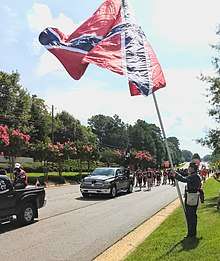Flaggers (movement)
Flaggers are one of the several neo-Confederate groups that operate openly in the United States. The best-known others are the Sons of Confederate Veterans and the United Daughters of the Confederacy.

Flaggers usually operate at the state level. Their primary purpose is to make the Confederate battle flag as visible as possible. They carry it at demonstrations and other public events, and erect it on private land. These flags are frequently visible from major highways, and have often been the subject of controversy and legal efforts to have them removed.[1][2][3] They (as individuals) lobby or appear at meetings to speak against removal of Confederate monuments and memorials. Some are anti-Abraham Lincoln and for the right of states to secede, i.e., that the Confederacy was legitimate under U.S. law.[4]
Georgia origin of flaggers
The earliest documentation of a flagger group as an organization is the Virginia Flaggers, whose Web site says they were founded in 2011. However, the flagger movement first appeared, spontaneously and unorganized, in Georgia in 2001.
The flag of Georgia from 1956 to 2001 incorporated the Confederate battle flag. Responding in part to pressure from civil rights groups who threatened an economic boycott of Georgia, Governor Roy Barnes "ramrodded" a flag change bill through the Legislature.[5] The new, hastily-designed flag, which even many of its supporters thought ugly,[5] was in use from 2001 to 2003. The North American Vexillological Association called it the worst-designed state flag in the country.[6] It included the Confederate battle flag as just one of five flags that have flown over Georgia.
There was widespread opposition to the new flag, deemed the "Barnes flag". It led, according to Barnes himself, to his defeat for reelection two years later; the flag was a major issue in the election.[5] A new flag was designed. In a non-binding 2004 referendum, 73% of the voters expressed a preference for the new flag, based on the first Confederate national flag, the Stars and Bars, over the 2001 design. (A return to the 1956 flag with the Confederate battle flag, desired by some, was not on the ballot.)
Flaggers, as they were soon called,[6] began displaying the Confederate battle flag, or the 1956 Georgia flag which contained it, in 2001. They appeared at political rallies and at public appearances of legislators who had voted for the Barnes flag.
Current flagger groups
As of 2018, the active flagger groups are:
- Virginia Flaggers, formed in 2011,[7] have installed Confederate flags across the state.[8] It was they who, according to the credits, posted the YouTube video cited.
- Tennessee Confederate Flaggers[9]
- Alabama Flaggers[10]
- Delta (Mississippi) Flaggers, who make a point of demonstrating in front of businesses, schools, or any organization that does not fly the Mississippi flag (which contains the Confederate Battle Flag).[11]
- Georgia Flaggers[12]
- "The Sons of Confederate Veterans aims to raise a Confederate flag in all 100 counties in North Carolina in an initiative called 'Flags Across the Carolinas.' The initiative hopes to raise 'mega-sized,' 20-by-30-foot (6.1 by 9.1 m) Confederate battle flags across the state by placing them on private properties with the consent of the property owners." A separate group, Alamance County Taking Back Alamance County (ACTBAC), sought to do the same at four locations surrounding Chapel Hill, North Carolina.[13]
References
- Basham, Marc (July 22, 2018). "East Idaho Confederate flag display creates controversy". Idaho Journal Statesman.
- Renkl, Margaret (January 29, 2018). "A Monument the Old South Would Like to Ignore". New York Times. Retrieved January 29, 2018.
- Holley, Peter (June 25, 2015). "The 'terrifying' Confederate statue some Tennesseans want to hide". The Washington Post. Retrieved September 2, 2017.
- Veritas (pseudonym), Invictus (Latin for "Undefeated Truth"). "The Founding Fathers vs. Abraham Lincoln. A Constitutional and Legal Rebuttal of Lincoln's First Inaugural Address)". Virginia Flaggers. Retrieved July 20, 2018.
- Peterson, Larry (April 20, 2003). "The fight in Georgia for a new state flag". Savannah Morning News. Retrieved August 2, 2018.
- Jackson, Edwin L. (June 8, 2017). "State Flags of Georgia". New Georgia Encyclopedia. Retrieved August 2, 2018.
- Virginia Flaggers' web site
- Associated Press (July 20, 2018). "Virginia county waves goodbye to Confederate flag along I-64". WSLS.
- "Tennessee Confederate Flaggers Blog". 2013. Retrieved July 30, 2018.
- Blandin, Venton (June 25, 2015). "Alabama Flaggers stand guard to protect confederate monuments". WBMA. Retrieved July 30, 2018.
- Dalbey, Beth (February 14, 2018). "Mississippi Cop Fired After Confronting Confederate Flag Wavers". Patch.com. Retrieved July 30, 2018.
- Burns, Steve (August 6, 2018). "Despite parade ban, Confederate flag displayed at annual Alpharetta event". Atlanta Journal-Constitution.
- Tate, Karlton (March 8, 2018). "Some groups want more Confederate flags in N.C. — here's how Orange County is reacting". Daily Tar Heel.
External links
- Georgia Flaggers - Flagging Scalwag Politicians - Bremen, GA on YouTube (2002 parade, posted by VaFlagger).